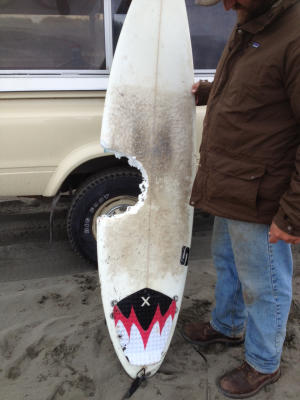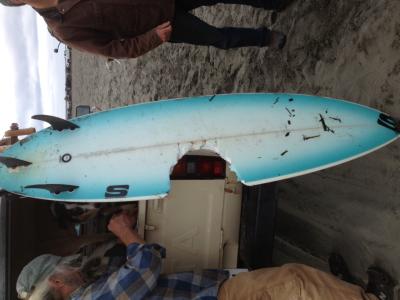VIA – MERCURY NEWS
A surfboard found on the North Jetty Tuesday afternoon shows evidence of a shark… (Luke Ramseth)
Eureka Times-Standard
mercurynews.com
EUREKA — A likely great white shark attack in Humboldt County left a group of surfers scrambling to save a man’s life.
The victim — a 25-year-old surfer whose name has not yet been released — is expected to survive. He underwent surgery and was listed in fair condition this afternoon. The attack comes one week after Francisco Javier Solorio Jr., 39, of Orcutt, was killed after being bitten by a shark in Santa Barbara County.
According to witness accounts, the attack occurred around noon at Bunkers surf spot off the North Jetty. A number of people, including surfer David Hargrave, were in the water and heard the victim calling for help.
Hargrave and other witnesses said the man was able to get to shore on his own power, but was bleeding profusely. Ian Louth, an off-duty first responder, applied pressure to the man’s wounds while he was loaded into a vehicle to be transported to the hospital, witnesses said.
Blue Lake resident Jason Gabriel drove the victim from the water’s edge to the intersection of U.S. Highway 101 and Myrtle Avenue, where emergency personnel met them. Gabriel said he doesn’t know the victim, but put him in his truck as fast as he could.
“I happened to be driving by as they were pulling him out of the water,” Gabriel said. The victim had about four 12-inch long gashes from his ribs to below his hips.
“It punctured all the way through. There were guts and meat hanging,” Gabriel said, adding that the victim appeared to be in shock. “He was going ‘Oh my God, oh my God.'”
A sheriff’s office press release said the man’s injuries were serious — including an approximately 14-inch bite wound — and he was transported to St. Joseph Hospital for surgery.
Jennifer Savage, Humboldt chapter of the Surfrider Foundation chairwoman, said the North Coast surfing community was shaken by the attack, which came during a period of good weather and ideal surf conditions.
She said shark bites are rare to begin with, and that it’s typically swimmers or divers who suffer fatal injuries.
“It’s really unusual for fatalities to be surfers,” she said, adding that the surfboard provides slim, but sometimes lifesaving protection.
Local surfer Benjie Rose said he had a close call with a shark near the North Jetty last year. Rose was hanging out on Samoa Beach today when he got a call about the attack and immediately drove south to Bunkers to talk to some of his fellow surfers.
“It hit me straight from below,” Rose said of the shark that “bumped” him last year. “It broke my board.”
He managed to swim and belly surf his way to the beach. Rose said he’s heard that adult great white sharks often “bump” surfers, while younger great whites are more likely to bite.
Adam Brown, an Arcata resident and independent researcher who has been studying and tracking great white sharks since the early 2000s, said they can be found off the North Coast year-round. Great white activity peaks from the end of August to the beginning of December, he said.
“If you are a surfer up here and you go in the water in the fall, the odds are good that a great white has swam by you at some point, and you didn’t even know it,” he said.
Brown said today’s attack was likely caused by a great white, judging by the size of the bite in the victim’s surfboard. While the great white is the area’s most common shark, it isn’t the only one. Mako sharks, blue sharks and salmon sharks can all be found off the coast, he said, although interactions with those sharks are less common.
Brown said it’s more likely to die in a car accident on the way to the beach than to be attacked by a shark. Certain ocean conditions might conflict with a shark’s ability to identify a food source.
“In most cases, sharks have a pretty good idea of what their food sources look like,” he said. “But if the water gets really murky, either because of heavy wave or wind action, that’s when a person on a surfboard starts looking a lot more like a seal.”
Brown, who also surfs, said the best precautions surfers can take are going with friends and avoiding places — like the mouth of the Klamath River, Moonstone Beach and the North Jetty — where higher shark concentrations have been recorded.
“It really is unfortunate, but this kind of thing does happen,” Brown said. “This is just a part of living up here and taking those risks when you enter the water.”
For the original post go here:
 Become A Sponsor!
Become A Sponsor!If you have a product or service that is a good fit for our surf community, we have opportunities for you to sponsor this blog! Download our media kit now!


